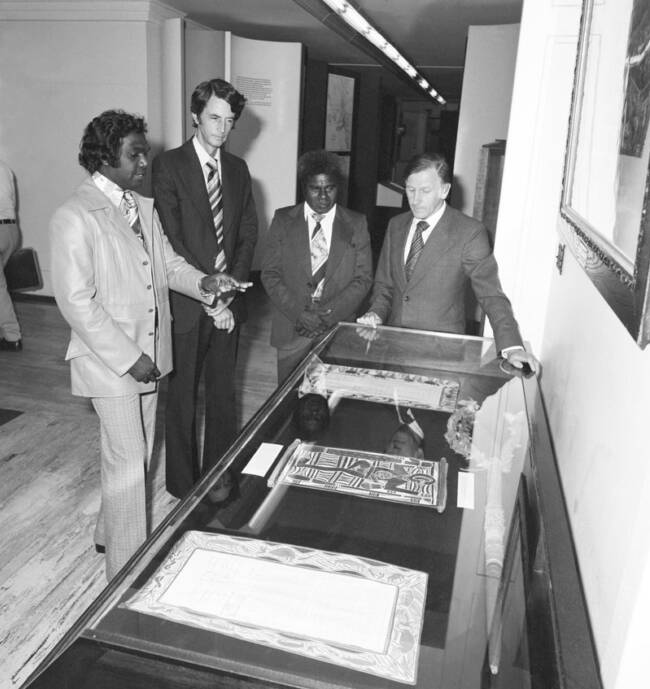Our history
Since they were first established, Aboriginal land councils have won back almost half of the land mass of the Northern Territory and 85 percent of the coastline of traditional Aboriginal land owners. Significant areas of Aboriginal land have been opened up for development through agreements with Aboriginal peoples.
Gumatj leader, Galarrwuy Yunupingu (left) and Silas Roberts, NLC Chairman at Parliament House in 1977 with Jeremy Long and the Minister for Aboriginal Affairs, Ian Viner (right), looking at the two bark petitions presented to the House of Representatives in 1963. Source National Archives of Australia.
Scientific evidence dates Aboriginal presence in northern Australia to 60,000 years and southern Australia to 40,000 years. European settlement of the Australian continent began in 1788 when a British penal settlement was founded at Sydney Cove.
Colonisation spread across the continent and its islands. Aboriginal and Torres Strait Islander nations resisted the occupation of their lands by pastoralists and the destruction of their way of life.
Following unsuccessful attempts to establish settlements in northern Australia, colonial officials, pastoralists, prospectors and missionaries began to arrive in what is now the Northern Territory in the latter part of the 19th Century.
Traditional hunting grounds and fertile lands were taken by pastoralists. Many groups were left to live on unproductive land. Despite receiving unjust compensation for their labour, many worked on cattle stations and were able to maintain their historic cultural links to their land.
In the 1960s the land rights movement began to gain momentum. In 1973 the Woodward Commission of Inquiry into the appropriate way to recognise Aboriginal land rights in the Northern Territory was announced. The Northern and Central Land Councils were formed in the same year to assist with the work of the Commission.
“I have ... felt very strongly the lack of any cohesive organisation linking these various people to whom I have spoken. There is no body or council which can speak for the Aborigines of the Territory as a whole. ... They have no means by which they can formulate a generally supported claim or make their voices heard in a way likely to influence ultimate decisions.” - Justice Woodward
The Aboriginal Land Rights Act was intended to be a model for national land rights legislation. Opposition from State Governments and the mining industry, however, defeated this objective.
Since the introduction of Aboriginal Land Rights Act (Northern Territory) in 1976 the Act has been the subject of continual attacks and attempts to reduce the rights which Aboriginal people had reclaimed to manage their land.
Previous Northern Territory Governments’ policy of extensive legal challenges to land claims has continued over the life of ALRA. Such challenges have ignored the obvious strength of claimants’ cases, the efficacy of the Land Councils’ approach and the failure of nearly all of their challenges. Whilst wasting millions of taxpayer dollars, this policy delayed the outcomes of land claims and delayed or denied Aboriginal people their rights to reclaimed land.
Many claimants have died before their claims have been successfully resolved.
Despite the challenges, Land Councils have won back almost half of the land mass of the Northern Territory and 85 percent of the coastline of traditional Aboriginal land owners. Significant areas of Aboriginal land have been opened up for development through agreements with Aboriginal peoples.
Aboriginal landowners continue to rely on the natural environment for spiritual, social and economic well-being.
Governments are increasingly recognising the critical role that traditional Aboriginal landowners have in caring for the land, waters, seas and flora and fauna in the Northern Territory.
As the ability of Aboriginal peoples to succeed in further land claims diminishes, the role of Land Councils is shifting to focus more on land management and development.
Timeline
- 1963 – The Bark Petitions: Yolgnu peoples from northeast Arnhem Land present the Commonwealth government with a petition of bark paintings protesting a bauxite mine lease granted on their land.
- 1966 – The Wave Hill Walk-Off: Gurindji stockmen and their families walk off Wave Hill Station, demanding fair wages and the return of some traditional lands.
- 1967 – Constitutional Change: Ninety-one percent of Australians vote in a referendum to give the Commonwealth power to make laws with respect to Aboriginal people and count them in the census.
- 1971 – The Gove Land Rights Case: Yolgnu peoples of Yirrkala unsuccessfully seek a court order restraining the Nabalco mining company’s operations.
- 1972 – Tent Embassy: Aboriginal peoples set up a tent embassy on the lawns of Parliament House in Canberra to protest the lack of land rights and other issues.
- 1973 – Commission of Inquiry: The Federal Government appointed Justice Woodward to conduct a Commission of Inquiry into the appropriate way to recognise Aboriginal land rights in the Northern Territory. The Commission’s first report recommended the establishment of land councils in the Central and Northern regions of the NT to represent the views of Aboriginal people.
- 1974 - The Northern Land Council commences operations.
- 1975 – Gurindji Success: Prime Minister Gough Whitlam returns land to the Gurindji people almost a decade after they walked off Wave Hill Station.
- 1976 – Land Rights: Aboriginal Land Rights (Northern Territory) Act (ALRA) passed by Parliament of Australia with bipartisan support.
- 1977 - ALRA comes into effect. Most Aboriginal reserves become Aboriginal land with freehold title held by local Aboriginal people.
- 1978 – Yolgnu Justice: Fifteen years after the Bark Petitions were delivered to the Commonwealth Parliament, Yolgnu people receive title to their land through ALRA.
- 1992 – Mabo: The High Court of Australia ruling in the Mabo v Queensland case grants Native Title rights.
- 2008 – Blue Mud Bay decision: On 30 July the High Court of Australia granted Aboriginal peoples sea rights to approximately 85 percent of the NT coastline, heralding a new era in the fight for land and sea rights.


